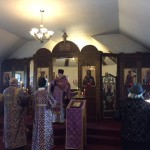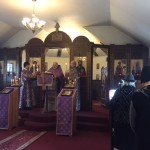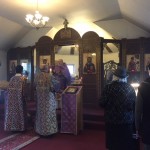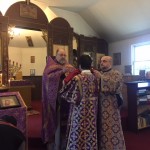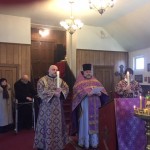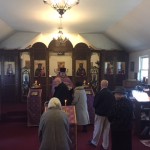On March 17, on the First Sunday of Lent, also known as celebration of the Triumph of the Orthodoxy, St. George parish had a nice liturgical service. Our Rector, Archpriest Igor Tarasov served the Liturgy of St. Basil the Great. After the Scripture readings he preached a homily in Russian. An English translation of that homily is as follows:
“Dear brothers and sisters! We have started Lent and passed the first week of that special time. On this First Sunday of Lent we commemorate the triumph of the sound Church doctrine of veneration of the holy images, the holy icons. We know that icons are very important in our religious and spiritual life. We have them in the churches, we venerate them, keep them in our homes. Our tradition calls them “windows to heaven”. We believe that they represent God and His Saints and show us their presence. Through them we may mysteriously know about God’s Kingdom and have an awareness that God is with us. We also believe that with or without icons God is with us because He knows about us and He sees us.”
“In today’s Gospel we heard that when Jesus saw Nathanael coming to him, He said, “Behold, an Israelite indeed, in whom is no deceit!” Nathanael said to Him, “How do You know me?” Jesus answered and said to him, “Before Philip called you, when you were under the fig tree, I saw you.” (Jn. 1, 47-48). Nathanael was surprised that Jesus saw him in some secret or intimate moment of his life. But he was probably much more surprised that Jesus had read the thoughts of his heart. God is He who sees. He sees everything, He reads every thought, He knows about everything. And we constantly live in the sight of God. Does it mean that we may be threatened like children whose babysitter says, “I am watching you, you better behave!”? Does it mean that?”
“Some prisons are now equipped with video cameras placed at such spots that every jail cell is within view. Guards can see everything that goes on. Nothing can be hidden from the probing eyes of the camera. Such cameras are now found in banks, hospitals and stores. Some time ago many cameras became installed in the traffic lights and other spots in New York City. All these cameras remind one of the all-seeing eye of God that is painted on many Orthodox icon screens. Is this what it means to live constantly in the presence of God who sees all? Is God a great eye constantly watching us to see if He can catch us off guard? Certainly not!”
“God does not see us from the top of some tower, but from the Cross. Through Christ we have learned that the eyes of God are the eyes of tender love and mercy. God sees and watches us not because He wants to punish us but because He loves us. In fact, He loves us so much that He cannot take eyes off us. As a mother cannot take her eyes off her newborn baby, so the Lord does not withdraw His eyes from us. As the Scripture says, “He does not withdraw His eyes from the righteous” (Job 36, 7). He sees our sufferings and pain. Because He sees, He is able to comfort, and strengthen, and help. And because we know He sees, we can say along with the Psalmist, “Though I walk through the valley of the shadow of death, I fear no evil”. Why no fear? “For Thou art with me” (Ps. 22, 4).”
“God sees us in our sorrow. He sees us also in our sin. But even in our sin He looks upon us with love summoning us to repentance. He sees what is in our hearts. He saw what was in the Nathanael’s heart in today’s Gospel. He sees all mankind and every person. He saw Abraham of old. He saw His people suffering in Egypt. He sees us today. He sees us in our sorrow to comfort us and in our sin to forgive us. He sees us from the Cross. He sees us with love and it is His seeing that keeps us at our best. If the eyes of Christ are windows through which God sees us, they are also mirrors in which we see ourselves as cared for and loved by our Creator and Redeemer.”
“Dear brothers and sisters! This is a very important aspect of our faith: we believe in God incarnate. This is the Orthodox faith – to believe in God who became man. And for that reason God being the Son of Man can and should be imaged. For that reason His images should be venerated. Because through Jesus Christ God sees us and we see God, as well as we see ourselves being loved by Him.”
“What a difference it would make in our lives, if we remembered that everything we do, and say, and attempt, and think, and imagine is going to be done under the loving eyes of God. It would truly change our lives. And the icons we have are of big help. They remind us of God’s eyes, but they also make us able to see through them the heavenly glory. Therefore, the Church call them the “windows to heaven” and a “theology in painting”. Theology is a study of God. Through the icons we can study God, know God and simply feel God, feel that He is with us. We can feel that He is loving and caring; that He knows everyone of us from our beginning, from the womb of our mothers.”
“Dear brothers and sisters! Let us rejoice along with the whole Church on that day of the triumph of the Orthodox faith. Let us also rejoice for knowing that the loving and caring God is with us in an invisible way, as well as visibly in His holy icons. Let us ask Him that we may pass this holy time of Lent under His sight and care, with His love, to be worthy also to join Him in heaven. There we are going to see Him directly and not through His images. Let us always wish that!”
The choir prayerfully performed penitential hymns during preparation for Holy Communion.
After the Liturgy dismissal the Rector performed prayer service of the Sunday of Orthodoxy solemnly declaring the Orthodox faith and proclaiming eternal memory to the champions of that faith and the polychronion to the Church hierarchy and Orthodox Christians.
At the conclusion of the service the Rector congratulated the parishioners on the completion of the first week of Lent and wished them to continue an endeavor of further observance of the fast.

